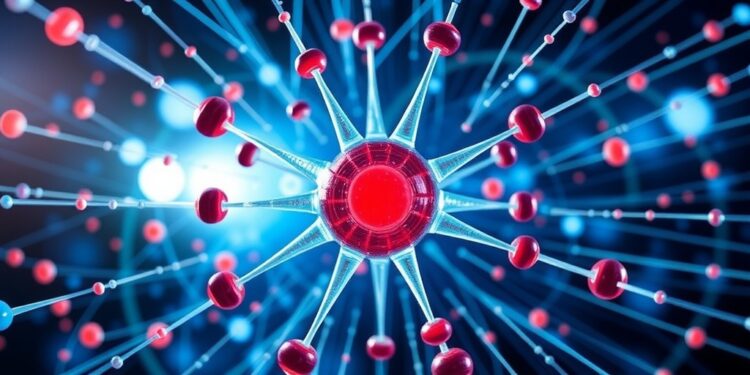University of Queensland researchers have recently unveiled significant findings in the domain of muonic atom research. This intriguing breakthrough offers promising avenues for nuclear physics experiments that could reshape our understanding of atomic structures. At the forefront of this research is a dedicated team from the UQ School of Mathematics and Physics, who have seamlessly merged theoretical insights with experimental validations. Their combined efforts present a compelling case that nuclear polarization—the phenomenon responsible for distortions in the nucleus of an atom—does not compromise the integrity of muonic atom studies.
Dr. Odile Smits, a co-author of the study, elaborated on the implications of their findings, emphasizing that this research provides a vital pathway to utilize muonic atoms for a deeper comprehension of nuclear magnetic structures. Muonic atoms are considered truly remarkable due to their unique properties—mimicking the role of electrons while having significantly greater masses. This mass variance enables muons to orbit the atomic nucleus with much closer proximity than standard electrons, thereby revealing a more detailed glimpse into the nucleus’s architecture.
However, previous investigations involving muonic atoms encountered substantial challenges, primarily due to uncertainties surrounding the impact of nuclear polarization on hyperfine structures. Hyperfine structures are causal factors for minute energy splits observable within atoms, and any distortion exacerbated by nuclear polarization can obscure these delicate characteristics. This distortion can be compared to the gravitational pull of the moon that generates tidal movements on Earth, underscoring how external influences can shape and modify intrinsic properties.
Crucially, the research conducted at the University of Queensland has elucidated that the effects of nuclear polarization on muonic atoms are considerably less significant than earlier estimates suggested. Dr. Smits confidently proclaimed that the nuclear polarization influences viewable in muonic atoms are marginal, paving the way for a thorough investigation into these exotic atomic forms. The findings removed a substantial roadblock that had previously inhibited scientific inquiry into muonic atoms, marking a transformative moment in the field of nuclear physics.
Associate Professor Jacinda Ginges, who spearheaded the research team, articulated the significance of this breakthrough, describing it as an opening for innovative experiments poised to enhance our understanding of nuclear structures and the fundamental laws governing physics. The foundational insights drawn from this study may yield transformative advancements that extend beyond simple atomic observations to unraveling deep-seated mysteries of matter and energy interactions.
Collaboration played a pivotal role in the success of this research endeavor. The UQ team partnered with Dr. Natalia Oreshkina from the Max Planck Institute for Nuclear Physics in Heidelberg, Germany. Dr. Oreshkina’s independent calculations corroborated the team’s findings, adding credibility and weight to their conclusions. This collaborative spirit is emblematic of the broader scientific community’s mission—pushing the boundaries of human understanding through shared knowledge and rigorous examination.
As a consequence of this groundbreaking study, new experimental efforts are anticipated to emerge, particularly at prominent research facilities such as the Paul Scherrer Institute in Zurich. Researchers there are planning to delve deeper into the characteristics and behavior of muonic atoms, motivated by the insights gained from UQ’s recent work. Such programs are expected to catalyze a new wave of research that could redefine contemporary physics frameworks, shedding light on the intricate nature of atomic structures.
The research itself, which has been meticulously detailed in the leading journal Physical Review Letters, highlights the remarkable potential that lies at the intersection of theoretical predictions and practical experimentation. By demystifying the effects of nuclear polarization on muonic atoms, scientists are now armed with a clearer perspective to embark on next-generation experiments. These new avenues of inquiry promise not only to validate existing theories but also to challenge and refine our understanding of the fundamental constituents of matter.
The broader impacts of this research extend into various realms, including enhanced applications in nuclear technology, improved techniques in particle physics, and wider implications for fields that rely on the delicate interplay of forces at the atomic level. The potential revelations about nuclear structures could resonate through many scientific disciplines, leading to unforeseen innovations and advancements.
In summation, the discovery made by researchers at the University of Queensland signifies an important milestone in nuclear physics, heralding transformative possibilities in the study of muonic atoms. As researchers continue to explore the profound insights born from this work, the scientific community remains poised at the brink of new discoveries that could further illuminate the enigmatic world of atomic and subatomic particles.
As discourse on nuclear physics evolves, it is essential for the scientific community to remain aware of the implications of such findings. This study might inspire further investigations that yield new technologies or methodologies, ultimately enhancing our understanding of the universe at its most fundamental levels.
This remarkable advancement not only highlights the capabilities of modern science but also exemplifies the importance of interdisciplinary collaboration in addressing complex scientific questions. The future of muonic atom research appears bright, and as we stand on the threshold of a new era in nuclear physics, the possibilities for discovery and innovation are boundless.
Subject of Research: Understanding the nuclear polarization effect in muonic atoms.
Article Title: Smallness of the Nuclear Polarization Effect in the Hyperfine Structure of Heavy Muonic Atoms as a Stimulus for Next-Generation Experiments.
News Publication Date: 7-Mar-2025.
Web References: Physical Review Letters
References: None reported.
Image Credits: None reported.
Keywords
muonic atoms, nuclear polarization, hyperfine structure, nuclear physics, University of Queensland, experimental research, cosmic rays, atomic structure, fundamental physics, interdisciplinary collaboration, scientific discovery, nuclear technology.
Tags: advanced atomic modelsatomic structure breakthroughschallenges in muonic atom studieshyperfine structure studiesimplications of muonic researchmuonic atoms researchmuons in atomic physicsnuclear magnetic structuresnuclear physics experimentsnuclear polarization effectstheoretical and experimental physicsUniversity of Queensland research





